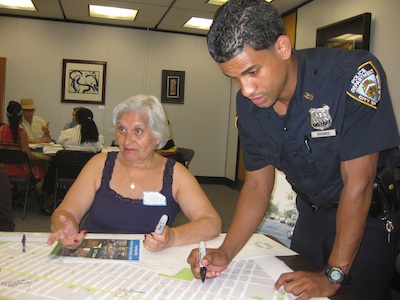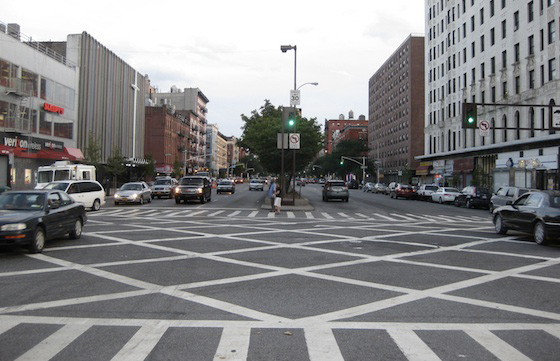Big ideas were in short supply at a workshop held Wednesday night to develop a badly-needed safety plan for Adam Clayton Powell, Jr. Boulevard. This year alone, three pedestrians have been killed in traffic crashes along the 100-foot wide avenue, but many of the workshop participants seemed focused on making it easier to drive through Central Harlem, not on saving lives. In an area where fewer than a quarter of households even own a car, more voices need to be brought into this discussion.
Between 2005 and 2009, 830 people were injured in traffic crashes on Adam Clayton Powell. That puts the street in the most dangerous 10 percent of streets in Manhattan, according to DOT. Crashes have claimed the lives of nine pedestrians since 2006; their average age was 62.
The avenue is dangerous in large part because it is a speedway. Its 12-foot wide lanes -- three in each direction, separated by a planted median -- are as wide as standard highway lanes. Between 20 and 66 percent of drivers on the street are speeding, depending on the time of day, according to DOT.
Wednesday's workshop was the beginning of a community process jointly sponsored by the Department of Transportation, Community Board 10 and the Manhattan Borough President's office to develop safety improvements for Adam Clayton Powell. Roughly a dozen DOT officials were in attendance, including Manhattan Borough Commissioner Margaret Forgione, Bicycle Program Director Hayes Lord and Assistant Commissioner for Education and Outreach Kim Wiley-Schwartz.
DOT officials briefly presented statistics showing the need for safety on Adam Clayton Powell and laid out the toolkit of safety devices that could be employed. Participants then broke into four groups to discuss particularly dangerous locations and what could be done to fix them. Pedestrian countdown clocks are already slated to be installed on the street this year, but the department was looking for additional suggestions from the community.
In those groups, however, the appetite for effective interventions to improve pedestrian safety was weak.
"I've never had a problem crossing Adam Clayton Powell," claimed Richard Toussaint, a former chair of the Riverton Tenants Association, in defiance of the demonstrably unsafe conditions. Toussaint admitted that he mostly drives to get around. His major proposals were to make Third Avenue two-way so that it's easier to drive south off the Third Avenue Bridge, and to cut more streets through Harlem's superblocks.
Henrietta Lyle, the acting chair of Community Board 10, repeatedly spoke in favor of maintaining high-speed conditions. When Thomas Lunke, the director of planning for the Harlem Community Development Corporation, said that "the lights are timed to make it a speedway," Lyle responded, "As a driver, I like that." Lyle also claimed she found it frightening and unsafe to drive at 20 miles per hour. Lyle primarily called for the addition of turning lanes and signals on area streets.

That isn't to say that no participants were interested in improving safety. "As a city, as a borough of Manhattan, we're supposed to be the most walkable," said Deputy Borough President Rose Pierre-Louis. "We need to be sure that for seniors, for children, it is."
Enmanuel Rosario, a police officer with the 28th precinct, called for a simplification of the triangle intersections created along the length of St. Nicholas Avenue, which he called confusing and dangerous for pedestrians. Most people supported extending the existing median, which currently ends just short of crosswalks, to serve as a pedestrian refuge island at intersections.
One of the four breakout groups called for neckdowns where Adam Clayton Powell intersects with major streets like 116th or 135th. That same group was also the only to endorse a DOT suggestion to narrow the traffic lanes to less than 12 feet, but even they specifically said that removing a lane would not be acceptable.
Hanging over the discussion, at times, was DOT's last proposal for traffic calming on Adam Clayton Powell, a buffered bike lane that would have replaced a traffic lane. Though that lane earned the unanimous endorsement of CB 10's transportation committee, the full board voted against it in 2009.
Bike lanes were not part of the toolkit presented by DOT, though they've been clearly shown by the department to improve pedestrian safety. When a Harlem CDC employee brought them up on her own, the DOT facilitator cut off the discussion as off-topic.







